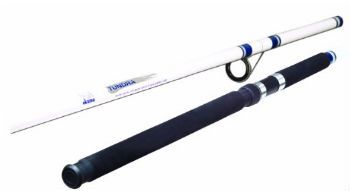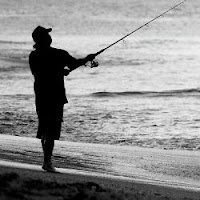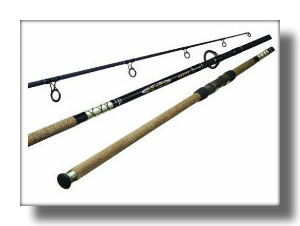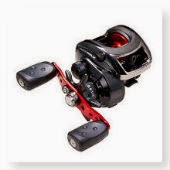How to Select a Surf Casting Rod
The surf casting rod helps solve one of surf fishing's biggest problems, casting distance.
You would think that you could walk down to the beach with your typical fresh water rod and reel and start fishing.
The problem is if you use a regular fishing rod your cast is probably not going to be far enough out in the water for what you need.
Having a proper surf fishing rod will help solve this problem.
So c'mon along and let's see what you’re going to need.
You would think that you could walk down to the beach with your typical fresh water rod and reel and start fishing.
The problem is if you use a regular fishing rod your cast is probably not going to be far enough out in the water for what you need.
Having a proper surf fishing rod will help solve this problem.
So c'mon along and let's see what you’re going to need.
Surf Casting
Letting the surf rod do the work.
The idea behind surf casting is to cast the bait or lure as far out into the ocean as possible. Hopefully, the cast will be far enough to land in water deep enough to have larger fish in it.
Casts that are too short will land in relatively shallow water. It is possible to catch fish in shallow water, but they will be smaller in size than those found in deeper water.
One solution to getting a long cast is to use a longer fishing rod or pole. With a longer rod, you can get a greater whip action thereby propelling the lure or bait a greater distance.
The surf fishing industry now uses specially designed surf casting rods that are typically 10-15 foot in length. These long rods are in two or sometimes three pieces that go together.
You will note from the above photo that the rod has an extended handle below the fishing reel for two handed use. Also, note that the flex in the long rod will provide a whip type action when the bait or lure is released.
Casts that are too short will land in relatively shallow water. It is possible to catch fish in shallow water, but they will be smaller in size than those found in deeper water.
One solution to getting a long cast is to use a longer fishing rod or pole. With a longer rod, you can get a greater whip action thereby propelling the lure or bait a greater distance.
The surf fishing industry now uses specially designed surf casting rods that are typically 10-15 foot in length. These long rods are in two or sometimes three pieces that go together.
You will note from the above photo that the rod has an extended handle below the fishing reel for two handed use. Also, note that the flex in the long rod will provide a whip type action when the bait or lure is released.
How to Cast With a Surf Rod
Putting the surf rod to work.
There are a number of different casting techniques, including the ground cast and the pendulum cast.
We won't be going over all of these casts here. However, there are a number of videos online that illustrate and teach the different casts.
Here is an example of a good cast to start off with. I recommend you start with this cast and then move up to more difficult casts as you grow in experience. How to cast a surf rod
Here's a good slow motion example of pendulum casting. When watching the video keep your eye on the weight and you'll see why its called pendulum casting. Pendulum Casting
It may sound strange and you may feel a bit out of place, but I recommend you practice your casting before you go the beach. Chances are when you go to the beach there will be other people walking past or around you. This is no time to be learning how to cast a surf rod. I encourage you to go to an open field somewhere and practice your casting before you go the beach.
The cast shown in the video below is just an easy cast.
We won't be going over all of these casts here. However, there are a number of videos online that illustrate and teach the different casts.
Here is an example of a good cast to start off with. I recommend you start with this cast and then move up to more difficult casts as you grow in experience. How to cast a surf rod
Here's a good slow motion example of pendulum casting. When watching the video keep your eye on the weight and you'll see why its called pendulum casting. Pendulum Casting
It may sound strange and you may feel a bit out of place, but I recommend you practice your casting before you go the beach. Chances are when you go to the beach there will be other people walking past or around you. This is no time to be learning how to cast a surf rod. I encourage you to go to an open field somewhere and practice your casting before you go the beach.
The cast shown in the video below is just an easy cast.
Fiberglass Surf Fishing Rod
Photo Credit: Me
Surf fishing rods can be made of a number of different materials. They are available in fiberglass, carbon fiber, and graphite.
Ideally you want a fishing rod that is easy to handle and yet durable.
A part of my surf fishing gear was the surf casting rod pictured above. It is a 10ft.' Fenwick Fiberglass surf rod. As you can see in the photo it is rated for 15-30 lb. fishing line and 2-6 oz. lures. As this was my first surf fishing rod I didn't want to spend too much money. The cost a few years ago was only about $50.00.
This is a good two-piece starter rod. It is very durable and easy to handle and I still use it when I'm fishing two lines.
Ideally you want a fishing rod that is easy to handle and yet durable.
A part of my surf fishing gear was the surf casting rod pictured above. It is a 10ft.' Fenwick Fiberglass surf rod. As you can see in the photo it is rated for 15-30 lb. fishing line and 2-6 oz. lures. As this was my first surf fishing rod I didn't want to spend too much money. The cost a few years ago was only about $50.00.
This is a good two-piece starter rod. It is very durable and easy to handle and I still use it when I'm fishing two lines.
A Good Starter Rod
 The Fenwick Fiberglass Surf Rod doesn't appear to be available anymore but a suitable replacement would be the Okuma Tundra Surf Glass Spinning Rods.
The Fenwick Fiberglass Surf Rod doesn't appear to be available anymore but a suitable replacement would be the Okuma Tundra Surf Glass Spinning Rods. It's available in a variety of sizes at very reasonable prices.
Graphite Surf Fishing Rod
Photo Credit: Me
After about of year of fishing I moved up to a graphite surf fishing rod. I selected graphite for the lighter weight and greater flexibility which provided more whipping action. I also increased the length to a 12ft. rod.
The fiberglass surf rod is a bit stiffer than the graphite which limited casting distance. With the graphite surf rod, I can cast further and get into deeper water.
The rod I selected, after some research, was an Okuma Solaris 12ft. with a line weight 20-40 lbs. and 3-8 oz. lure weight.
I use 20 lb. line with 4 oz. pyramid weights and 40 lb. leader.
The fiberglass surf rod is a bit stiffer than the graphite which limited casting distance. With the graphite surf rod, I can cast further and get into deeper water.
The rod I selected, after some research, was an Okuma Solaris 12ft. with a line weight 20-40 lbs. and 3-8 oz. lure weight.
I use 20 lb. line with 4 oz. pyramid weights and 40 lb. leader.
A Safety Precaution you MUST adhere to:
When you prepare your rig add a shock leader onto the line. The reason for using a shock leader is to prevent your line from breaking when you cast it. Here's the basic rules to adhere to.
The leader should be long enough that when casting you have 4 or 5 rotations of the leader on your fishing reel. So the leader should be, as a rough guideline, twice the length of the rod.
In addition, the strength of the leader line should be 10 times the weight in pounds. For example, if you intend to use a 4 oz. weight, the leader should be 40 lb. line.
When casting a surf rod there is tremendous stress put on the line by the momentum of the surf rod and weight. You don't want the weight to go flying through the air and injuring anyone. So these precautions must be adhered to for the safety of those around you.
When you prepare your rig add a shock leader onto the line. The reason for using a shock leader is to prevent your line from breaking when you cast it. Here's the basic rules to adhere to.
The leader should be long enough that when casting you have 4 or 5 rotations of the leader on your fishing reel. So the leader should be, as a rough guideline, twice the length of the rod.
In addition, the strength of the leader line should be 10 times the weight in pounds. For example, if you intend to use a 4 oz. weight, the leader should be 40 lb. line.
When casting a surf rod there is tremendous stress put on the line by the momentum of the surf rod and weight. You don't want the weight to go flying through the air and injuring anyone. So these precautions must be adhered to for the safety of those around you.
The Okuma Graphic Surf Fishing Rod
I love this rod
The Okuma Surf Rod that I own is still available and is in my opinion a fantastic fishing rod. If you really want a great rod even for the beginning surf fisherman the Okuma is a great rod.
I am confident that you will love the Okuma surf fishing rod.
I have had no problems with mine and it is 9 years old.
If I were going to get just one rod this would be the graphite surf rod I would get.
I have had no problems with mine and it is 9 years old.
If I were going to get just one rod this would be the graphite surf rod I would get.
Surf Fishing Rigs
What makes up my typical rig.
I use a 4oz. pyramid sinker and pompano rig for most of my fishing rigs.
Sinkers
There are essentially three types sinkers used in surf fishing:
1. Casting sinker. The casting sinker is a round teardrop shaped sinker that is often used when casting into rocky areas. This sinker doesn't have any sharp edges or corners that can get caught on rocks. Even though there are no sinkers that will ensure you won't snag on a rock the casting sinker is better than some of the others.
2. Pyramid sinker. This is the sinker I use. It is shaped like an upside down pyramid. The fishing line connects to the bottom of the pyramid in the center. The pointed end of the pyramid digs into the sandy bottom when it lands. The surface of the bottom where I fish is sand and the pyramid sinker anchors itself in to the sandy bottom. This is useful because it prevents the rig from being moved around by the normal wave action. The casting sinker tends to just roll around on the sandy surface and as such is not very useful when fishing over sand.
3. Breakaway sinker. This is another sinker that is good for fishing on a sandy bottom. It has tentacles that stick into the sand and help hold it in place.
Pompano Rig
A pompano rig is a short line with two hooks about a foot apart on short leads. One end of the line is hooked to the weight and the other end to a swivel that is connected to the main fishing line.
Other Surf Fishing Gear
There is not a lot of gear required to surf fish. You really just need a good sinker, hook arrangement, surf rod and reel properly strung with the correct line. It is good to have a rod holder also unless you want to hold the rod all the time. The rod holders are normally called a sand spike because you stick them in the sand.
Other than that a good place to sit is a good thing, so you can wait and watch your line. It is a really relaxing way to fish and de-stress from life.
Sinkers
There are essentially three types sinkers used in surf fishing:
1. Casting sinker. The casting sinker is a round teardrop shaped sinker that is often used when casting into rocky areas. This sinker doesn't have any sharp edges or corners that can get caught on rocks. Even though there are no sinkers that will ensure you won't snag on a rock the casting sinker is better than some of the others.
2. Pyramid sinker. This is the sinker I use. It is shaped like an upside down pyramid. The fishing line connects to the bottom of the pyramid in the center. The pointed end of the pyramid digs into the sandy bottom when it lands. The surface of the bottom where I fish is sand and the pyramid sinker anchors itself in to the sandy bottom. This is useful because it prevents the rig from being moved around by the normal wave action. The casting sinker tends to just roll around on the sandy surface and as such is not very useful when fishing over sand.
3. Breakaway sinker. This is another sinker that is good for fishing on a sandy bottom. It has tentacles that stick into the sand and help hold it in place.
Pompano Rig
A pompano rig is a short line with two hooks about a foot apart on short leads. One end of the line is hooked to the weight and the other end to a swivel that is connected to the main fishing line.
Other Surf Fishing Gear
There is not a lot of gear required to surf fish. You really just need a good sinker, hook arrangement, surf rod and reel properly strung with the correct line. It is good to have a rod holder also unless you want to hold the rod all the time. The rod holders are normally called a sand spike because you stick them in the sand.
Other than that a good place to sit is a good thing, so you can wait and watch your line. It is a really relaxing way to fish and de-stress from life.
Author is a participant in the Amazon Services LLC Associates Program, an affiliate advertising program designed to provide a means for sites to earn advertising fees by advertising and linking to Amazon.com















